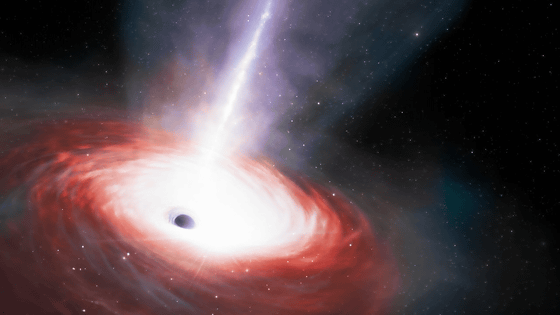by NOIRLab/NSF/AURA/J. da Silva/M. Zamani
National Science FoundationNational Institute of Optical and Infrared Astronomy (NOIRLab)A research team has discovered a black hole they named “LID-568” using data from the James Webb Space Telescope and the Chandra X-ray Observatory. LID-568 is a supermassive black hole that consumes surrounding matter at an astonishing speed that is over 40 times the theoretical limit.
A super-Eddington-accreting black hole ~1.5 Gyr after the Big Bang observed with JWST | Nature Astronomy
https://www.nature.com/articles/s41550-024-02402-9
NSF NOIRLab Astronomers Discover the Fastest-Feeding Black Hole in the Early Universe | NOIRLab
https://noirlab.edu/public/news/noirlab2427/
This Black Hole Is Eating Stuff at Over 40 Times The Theoretical Limit : ScienceAlert
https://www.sciencealert.com/this-black-hole-is-eating-stuff-at-over-40-times-the-theoretical-limit
Supermassive black holes have been observed to exist at the centers of galaxies, but it is not known in detail how these black holes grew to be so huge. However, it has been found that LID-568, which was born just 1.5 billion years after the Big Bang, is rapidly consuming matter, providing insight into the mechanism of black holes that grew rapidly in the early universe.
LID-568 was discovered by a team of astronomers from multiple institutions led by astronomer Hyewon Suh.
LID-568 cannot be seen in visible or near-infrared light, but it is visible on the James Webb Space Telescope.Near-infrared spectrometer (NIRSpec)Thanks to this, it was possible to detect weak X-ray radiation. However, it was not possible to determine the exact location by observing X-rays alone, so a surface spectrometer was used instead of the traditional slit spectroscopy. “We would not have been able to detect LID-568 without the James Webb Space Telescope,” said study co-author Emmanuel Farina. It was necessary for this purpose.”
Artist’s Impression of Fastest-feeding Black Hole in the Early Universe | NOIRLab
https://noirlab.edu/public/images/noirlab2427a/
by NOIRLab/NSF/AURA/J. da Silva/M. Zamani
By gaining a complete picture of LID-568 and its surrounding area, the research team discovered that there was a violent eruption of gas around the black hole. Based on the eruption speed and scale, it is speculated that most of LID-568’s large-scale growth may have occurred suddenly at once, and LID-568 iseddington limitWe found that it appears to be taking in matter 40 times faster than the
The Eddington limit is the balance between the radiation pressure from a black hole and gravity. When the tremendous light emitted by a black hole exceeds gravity, surrounding matter stops falling into the black hole, but observation results suggest that LID-568 will consume matter at a rate far exceeding that limit. I am.
Julia Schallwechter, one of the paper’s co-authors, described LID-568 as “having a feast.” “These extreme cases indicate that a fast feeding mechanism that exceeds the Eddington limit is one possible reason why supermassive black holes were observed in the early universe.”
Current theory suggests that supermassive black holes are formed by dead stars (light seeds) or the collapse of gas clouds (heavy seeds), the results of this study provide new insight into the formation of supermassive black holes from smaller black hole ‘seeds’. It is said that it will provide.
Copy the title and URL of this article
・Related articles
The largest jet in history, with a total length of about 23 million light years, was found to be emitted from a black hole about 7.5 billion light years away – GIGAZINE
Event Horizon Telescope releases even clearer color image of “black hole” – GIGAZINE
A video of a black hole simulated over a year using a supercomputer taking in spaghetti stars will be released – GIGAZINE
At the center of the galaxy there is a star that absorbed dark matter and became “immortal” – GIGAZINE
It turns out that carbon was born just 350 million years after the Big Bang, a big stone in the origin of life – GIGAZINE
Astronomers observe for the first time that a supermassive black hole at the center of a galaxy suddenly “awakens” – GIGAZINE
NASA’s James Webb Space Telescope discovers the most distant galaxy in history – GIGAZINE
Research results show that the true identity of the black hole is a star “Gravaster” made of dark energy – GIGAZINE
NASA simulates “what it would look like if you entered a black hole” – GIGAZINE
in Science, Posted by logc_nt
You can read the machine translated English article here.
